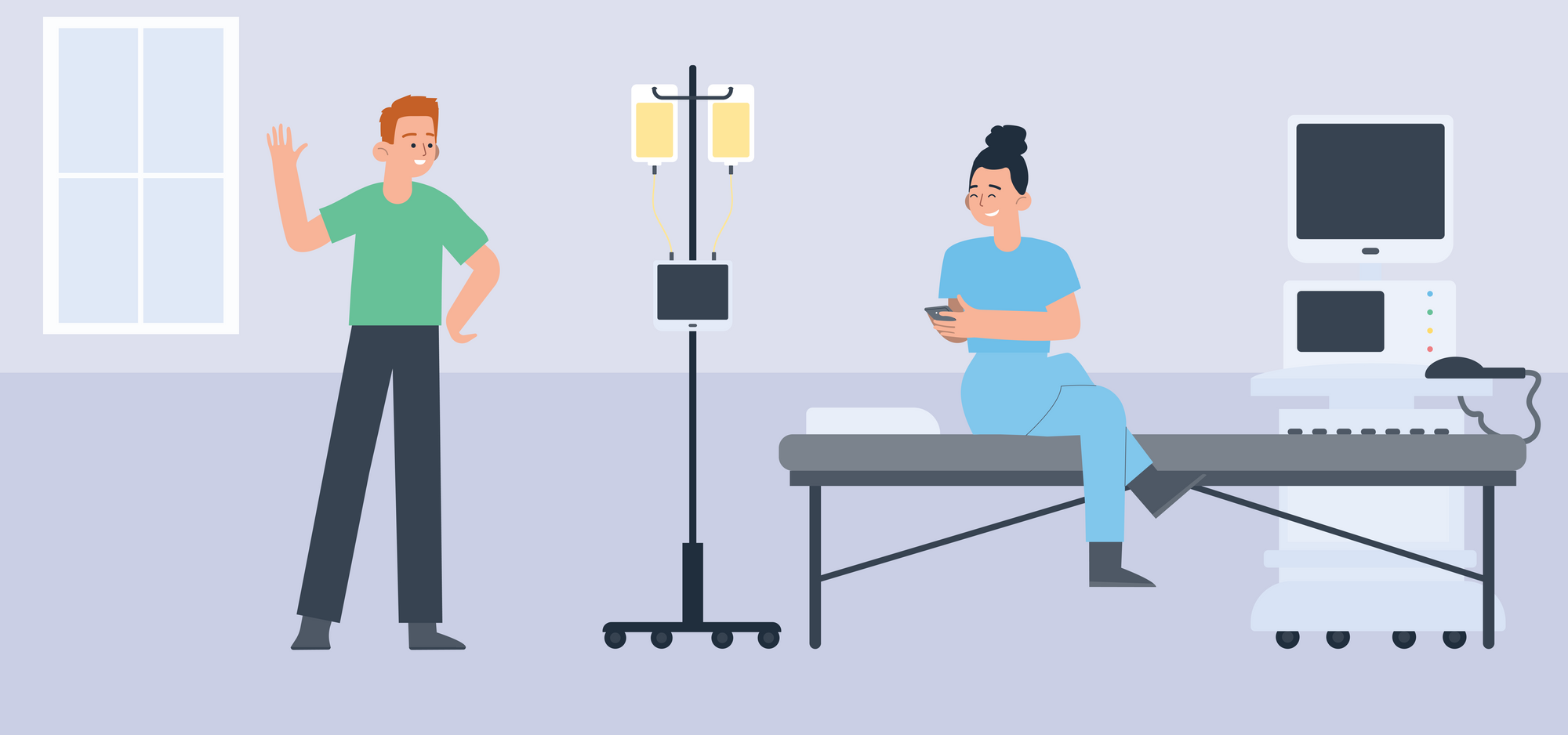When I started working at Light-it I heard the concept of digital healthcare again. Where did I hear that before? From the project of KQ-ra (K-ra and Q-ra), two homemade AI created by my husband, thinking of the psychological side of patients facing terminal illness.
When we met, he told me about his fantastic project, and honestly, it was the first time I heard about healthcare projects besides smartwatches tracking steps. He told me about the importance of being accompanied when facing hospitalization, and how hard it was for friends and family to fulfill that need. He witnessed this problem and took action when he was just 14 years old, by developing a simple program that notified him every time his hospitalized friend felt lonely.
This experience set ground to the foundation of a bigger project. Some years later, Martín started developing two AI solutions that, in a few words, work together to collect data from the patient and use it to send the appropriate positive stimuli.
One of the AI observes vital signs, listens to what the patient says, records what the patient does with his phone or computer, and more. With this information, the AI gives some feedback to the patient or doctors depending on the case. The feedback to the patient might be suggestions on games or videos, a book recommendation, a moment of talking, or even a video call with the family. The usual feedback for doctors is alerts of drastically vital signs changes.
The second AI observes the first AI and analyzes and monitors its patterns and activity to improve the performance and give better feedback.
Let me share with you the story of this young man who developed two whole AIs by himself for kids with terminal illnesses who unfortunately have to live in lonely hospitals.
Well, I would like you to introduce yourself… Tell us your name, age, where you are from, and how you started in programming…
Martin Von Spangenberg, I’m 27 years old and Argentine, though I currently live in Spain.
Well, I started programming at the age of 14, a little out of curiosity and a little out of a need to help a friend. I got both legs broken because of an accident, and I had to leave my rural town and live in the city hospital during recovery. While I was hospitalized, I made a friend, who was a leukemia patient. I knew he felt lonely sometimes and I felt that I could do something for him. That was when I began to develop a simple tool that sent me a notification every time my friend searched about socializing or ways to die in peace. Every time I had a notification, I went to the hospital to spend some time with him.
My friend died, but I knew there were lots of kids who were in a similar situation: feeling lonely and left aside when living in hospitals.
Later on, you got support to develop your major project, K/Q-ra. How can you explain it?
On one side, we have Q-ra, which is oriented to the medical field. The objective of Q-ra, which stands for "cure" -in Spanish-, is to accompany the patient with his process, especially in the psychological side of it, since I consider that it is a sector very neglected by health and people in general. It is an AI that uses pattern analysis, data, and user information provided by their devices, and in some cases by the medical instruments that the patient uses. The AI uses that information to do simple tasks such as alert doctors if there are relevant vital signs or mood changes, and more complex tasks like suggesting games or movies based on the patient's profile and obtained data.
Many times we forget that people are living in hospitals every day of their lives and they are no less for it… Q-ra aims to make the patient experience slightly better. At first, I chose to target a bot, since it met the needs, but it ended up improving and moving towards the current AI that it is now.
On the other hand, K-ra, or "face" -in Spanish-. It was a bit of a bot to analyze errors and patterns of its twin, although little by little it became a great virtual assistant to the point of helping me improve my development as a programmer.
Did you ever think about sharing that tool?
The truth is that at that point I didn’t, and I still do not want to share it because I still have a lot to develop and advance. I’d definitely want it to be something available to everyone; but I always liked to work on my own regarding the code, idea, and development.
How did you get the idea for Q-ra and K-ra? Did you plan for a long time? What need did you see that was not satisfied?
The idea of KQ-ra came out of curiosity, like almost everything in my life, and the experience I had with my hospitalized friend. This was intensified when someone decided to support my studies at the University, believing in me and my idea. Also due to the need to continue helping and growing in what I was doing. This tool started as a bot, collecting information and showing an answer for it... but over time it mutated into the AI that it is today, which seeks to go beyond the information provided by the user and look for what the user is interested in.
I think that the need that was not being fulfilled was the lonely experience people who spend their days in a hospital have. As a society, we are failing them, especially the little ones (children) who hardly understand why they are there and always have that illusion of getting ahead.
What is the main concept? I mean, what is the goal?
Its objective is to help, to accompany, to help them cope up with their disease. It is to be “what people cannot be” daily for those who use it. To be that ally that, through its use, makes progress in the recovery of a patient with a serious illness, since many times it has been proven that patients recover better, faster, or simply do it, due to good emotional support.
How was the development process of all those years?
The process was lonely, there were several years where I was developing and advancing on my own. Then we built a team. Finally, I decided to give it a pause due to a difference with the shareholders' team, as I wanted to keep the rights and intellectual property in my name.
At first, I used the programming languages I knew, then I learned new ones that led me to add them and improve every day. The project had its good and bad moments, like everything... days when there was more support from the community, days where I felt on my own... but I never gave up on what I wanted. Today I find myself on a break, looking to take it on my own soon.
How was the treatment with the patients?
Daily, friendly and satisfying. I think those are great words to define it, since at many points I spent my days with them, both in-person and from a distance. I always noticed a great improvement in each patient, especially in their day-to-day lives. We noticed how they were more animated and with a desire to get ahead.
Did you add features according to their needs?
Over time I managed to improve the AI so that the information could be worked on and improved by itself. I think it was the biggest challenge I had, but also what allowed me to be more efficient. Especially to be able to reach more patients, and in a better way... as personalized as possible.
Sure it was difficult to be working with terminally ill patients, did those difficulties encourage you to continue?
Yes, every day I felt that motivation to get up that we feel when we know that we are going to have a great day. It was a very good motivation to continue because something always heard when visiting the patients was their gratitude for not having forgotten them.
Did you think about taking the project to other fields? As well as a personal assistant for people with different needs or older people.
Yes, although it is something that I have reserved, I aim to bring this development to assist everyone who needs it. I believe that the psychological, therapeutic, and personalized accompaniment is every day closer to solving the problems.
Do you think there is enough funding in technologies for patient care??
Absolutely not, I had to bootstrap the project at many points of the process, and the few shareholders that are interested in the project, seek a profit by taking this technology to something more commercial. It is difficult, but not impossible if one is stubborn enough not to give up haha (laughs).
I wish this would change but for now, it's not really happening.
How will the project continue from now on?
For now, I’m looking to learn and improve as a professional, to one day continue the project and take it to a stable place.
There is no product without imperfections, since you manage people's health, is that intimidating or scary?
No, I was never afraid of that because I think that the people I have worked with were always very grateful and really committed in the initial process to analyze them; because they really wanted to be accompanied. I think there are ways to assist these people without the need for an AI, but if I stayed to wait for things to happen, they would never come… (shrugs) That's why I started with this. I believe that you do not have to be afraid of anything, and this is for any area. You have to face things with confidence and security.
Being a kid and facing a terminal illness is not an easy task at all. Your friends and family can not truly understand how you are feeling or be with you at all times. The idea of intelligence learning your wishes and needs, telling you jokes, or playing with you, makes you closer to feeling like a normal kid again.
In my opinion, this project not only helps patients to recover, keep them in a good mood or entertained, it actually saves the treasure of childhoods from being lost in hospital beds.

